Woodstock, New York is the cultural center of the Hudson Valley, with a deep history of art and self-expression. Acting as a home for artist colonies and a significant nurturer of the 1960s music scene, the small musical oasis holds decades of profound community and creativity. The village, which resides in the majestic Catskill Mountains, continues to honor its visionary spirit of the past, saturated in art, music, harmony, and of course, peace, love, and happiness.
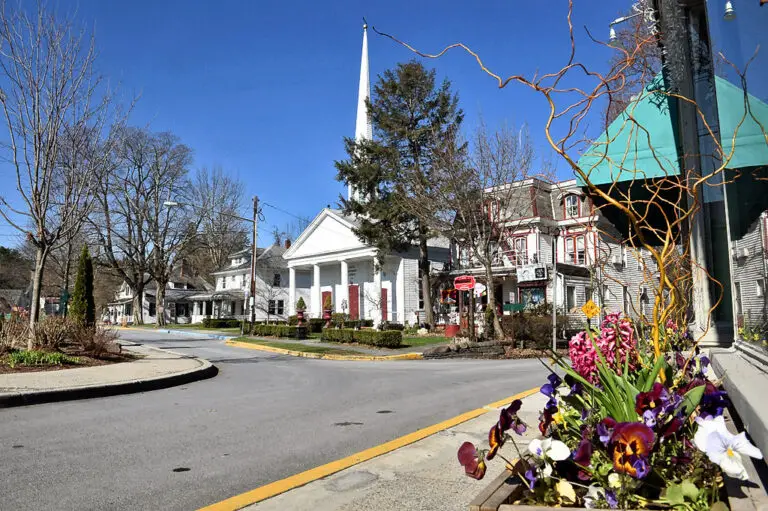
Those who’ve never even been to the town of Woodstock nor knew of its existence associate the name with music. There’s a common misconception that the town is the site of the historic 1969 Woodstock Music and Art Fair. The festival was originally supposed to take place in Woodstock, hence its name. However, the town backed out of hosting due to its inability to provide space and resources for the growing event. After which, Max Yasgur offered up his Dairy Farm in Bethel, NY an hour and a half away from Woodstock.
The name, however, stuck as it was too late to change it. However, it also represented more than just a location. Michael Lang, a co-founder of Woodstock Ventures, a team that produced successful festivals, understood the weight of the name. Woodstock was known for being a place where artists could come together free of judgment and welcomed with mutual support. A mystical place hidden in the mountains full of artist colonies, recording studios, and musicians such as Bob Dylan, The Band, Jimi Hendrix, plus many more flooding the streets with their music.
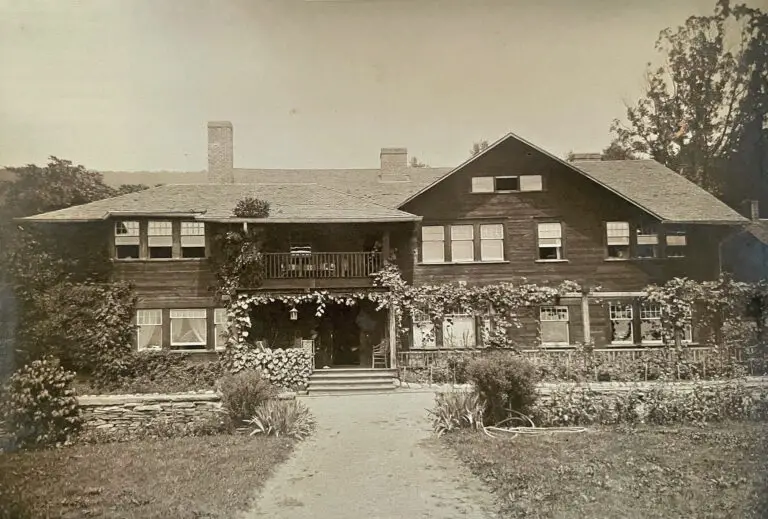
To fully understand how deep-rooted Woodstock is in artisticism, we must go back in time to 1902. Ralph Whitehead tasked two men, Bolton Brown and Hervey White with the job of finding a location to build his vision of an art colony. When Brown and White stood at the top of Overlook Mountain surveying the land below them, they knew they had found their community.
It was then, in 1903, that the Byrdecliffe Colony was born, followed by Hervey White’s venture of Maverick Art Colony in 1905 and the Art Students League, led by Birge Harrison in 1906. The small town became a sanctuary for people of all ages.
The legacy continued throughout the years. In 1938 Woodstock Playhouse was established. The building, which greets visitors as they drive into town from the throughway, was a place where people could see plays locally without traveling to the city. In 1988, the Playhouse burnt down. However, because the significance of the building was understood, efforts to rebuild were successful. Thanks to the Playhouse, many esteemed writers and actors have had their work showcased in the village over the years.
As times began to change, the Playhouse also went on to institute a number of midnight concerts and, later, found itself as host to the final concert in a series of performances known as the Sound-Outs, considered by many as a precursor to the Woodstock Festival.
Richard Heppner, Woodstock Town Historian
While these institutions made Woodstock the community it is, the ’60s folk-rock era stands as the emblem of the town’s musical history. Some of the most well-known artists to have resided in Woodstock are Janis Joplin, Van Morrison, Jimi Hendrix, and The Band, among many others. However, the most famous Woodstock resident by far would be Bob Dylan.
One could walk down Tinker Street in those days and run into Van Morrison, Tim Hardin, Jimi Hendrix, Bonnie Raitt or Joan Baez. You could shop at the Grand Union or A&P with the Band, Maria Muldaur or Dylan himself.
Happy Traum, Folk Musician
After living at manager Albert Grossman’s Woodstock home, Dylan decided to stay. In 1966, coming off the success of Highway 61 Revisited, he got into a motorcycle accident. As a result of his injuries, he stayed out of the public and kept to Woodstock. This era of Dylan’s life not only caused a lasting shift in his career but also a groundbreaking emergence in music.
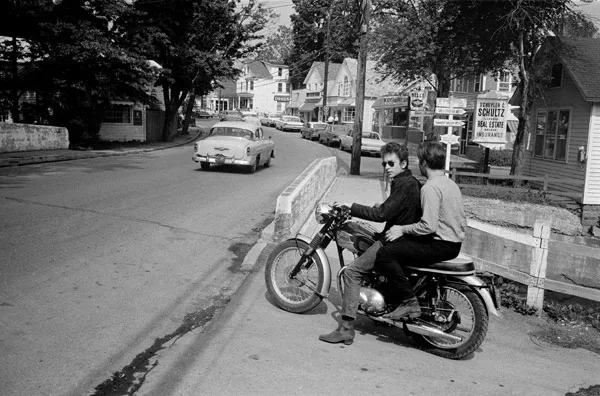
In the aftermath of Dylan “going electric” in ’65 at Newport Folk Festival, he hired an electric backup band, The Hawks, for his ’66 tour. The Hawks, now known as The Band, began recording sessions with Dylan during his hiatus. The product of these sessions, The Basement Tapes, was recorded in the basement of a house in Saugerties, NY called Big Pink. Currently, the house is still accessible to drive up to. The current owners rent it out for short-term stays, however, no one’s allowed in the basement.
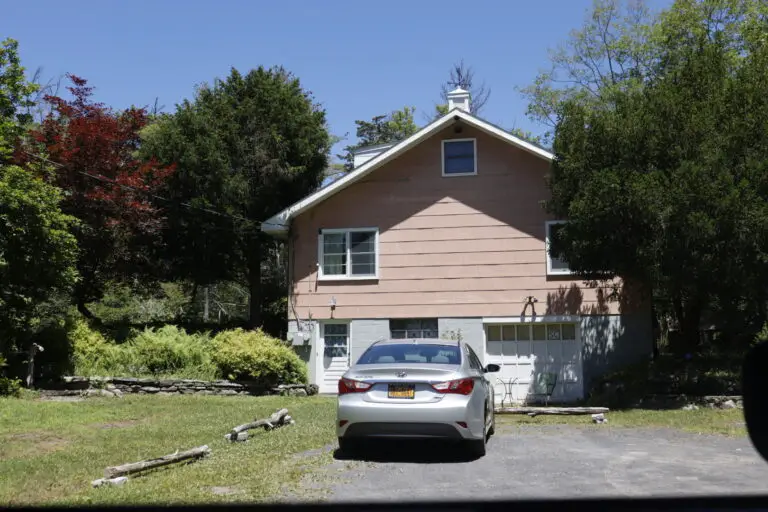
Today, Woodstock remains a relic of the past, honoring its culture, with preservation, reconditioning, and celebratory commodification. Gift shops, small businesses, and restaurants line the center of town. Just driving through the area, there’s a good chance of seeing Byrdcliffe Artist Residency or Maverick Concert Hall. Or perhaps Hotel Dylan right off Rt. 28, a hotel with rooms named after famous musicians. It’s not very common for towns to hold an Allen Ginsburg Birthday Celebration or for residents to have Volkswagen buses as mailboxes. However, traveling deeper into Woodstock will lead to the not-so-hidden gems of town – the venues.
In the middle of Woodstock is the Colony, an old hotel where travelers would stay on their way through town. The short pit stops were full of dining and entertainment while bands performed in the main room. The Colony, which opened in 1929, still stands as a music venue supporting local and touring artists. Every Monday night they hold their famous Colony open mic where anyone can sign up first come first serve, giving talented artists an expressive outlet.
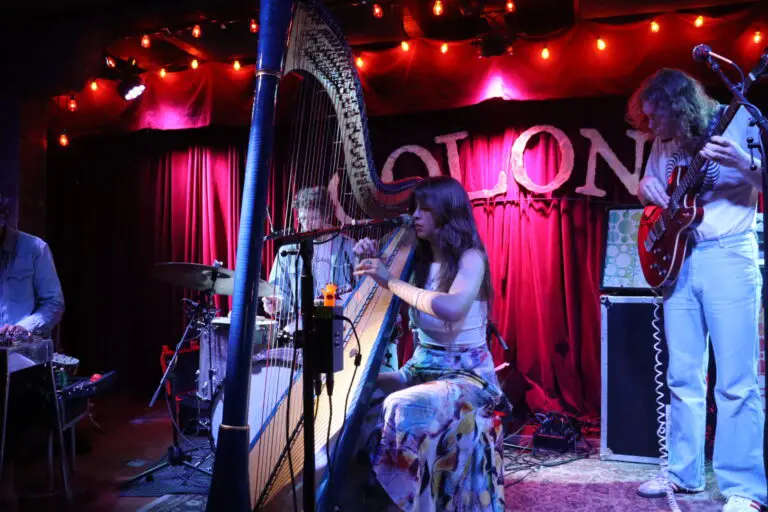
One local artist to play the Colony is Mikaela Davis. Davis’s show on June 27, emulated a genuine sense of community. She played with her opener, Rich Ruth, and her band, just as she has in the privacy of a studio. It truly felt like everyone was equal to each other and collaborating together. There was a lot of dancing, but there was also sitting and observing the events taking place.
The environment of the Colony is comparable to an actual artist colony. The versatile selections of instruments between Davis and her band Southern Star allowed everyone to bring something exciting to the mix. Along with styles of folk, classical, and psychedelia, the experimentation rang throughout the venue. The homage is not only in the name of the venue but the efforts of the community to keep art alive in this setting. To just experience one show at the Colony is to be unified with others and to understand the foundations Woodstock grew on.

Another highly significant place in Woodstock is the Bearsville Theater which also has a rich musical background. The theater along with Bearsville Studios is part of the Bearsville Center created by Albert Grossman, founder of Bearsville Records (Todd Rundgren, Foghat, NRBQ). After showing artists like Bob Dylan and Janis Joplin, the creative sanctuary that Woodstock is, he wanted to create a community for more artists to reap the town’s benefits.
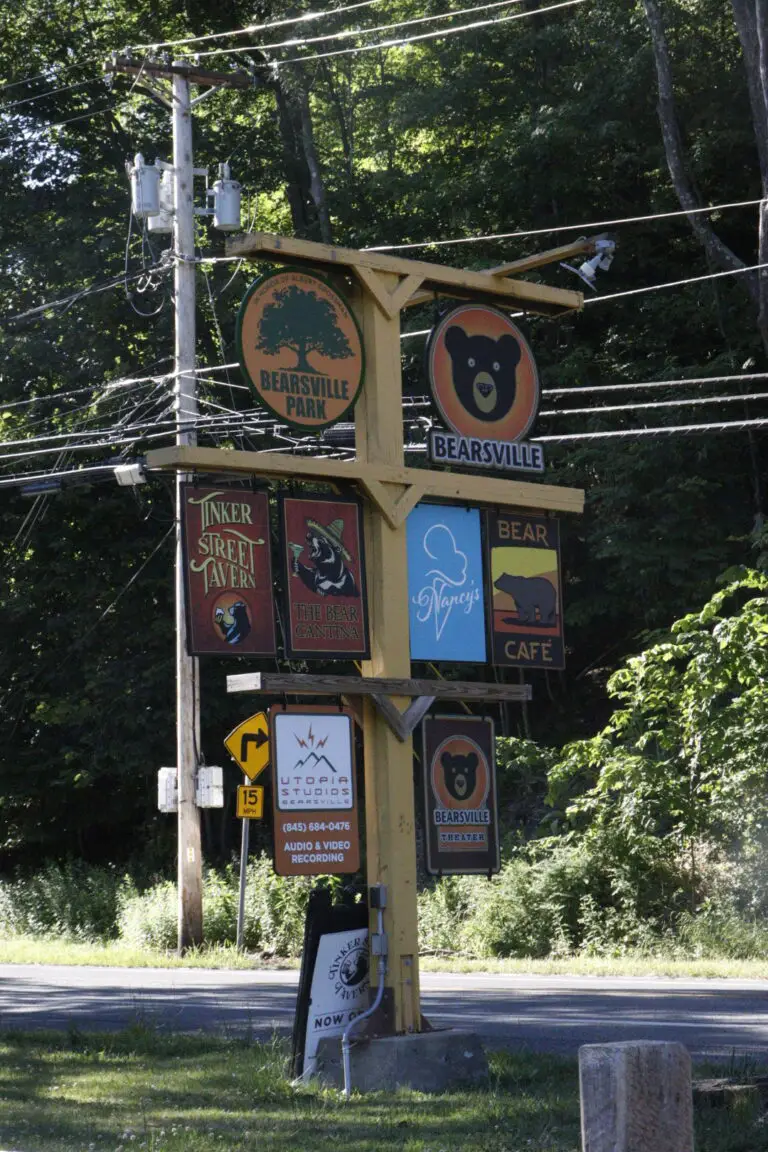
In 2019, entrepreneur Lizzie Vann, inspired by the shows at Bearsville, and the risk of it being replaced by a hotel, bought the property. Since then, Vann worked to revamp the complex, which includes a cantina, tavern, ice cream parlor, Utopia Sound Stage, and scenic outdoor spaces. In April 2024, Dayglo Presents, an entertainment and marketing company took over Bearsville. Dayglo, led by Peter Shapiro, also operates venues like The Capitol Theatre and Brooklyn Bowl. This merger has allowed Bearsville to evolve and book well-known artists, drawing even more live music fans to Woodstock.
The Bearsville Theater has a deep and amazing history that I am excited to preserve and lift, as we put our touch on a new era for this legendary Woodstock icon. We want to thank Lizzie Vann for her passion and dedication to Bearsville since she bought and lovingly restored the property in 2019. We appreciate her trust in us and are looking forward to a long working relationship.
Peter Shapiro, Founder of Dayglo Presents for Relix Magazine
On June 28, Chicago-based Indie-rock band Ratboys played at Bearsville Theater with co-headliner Water From Your Eyes from Brooklyn. The show brought in fans from everywhere. Fans of each band, locals just there to see a concert, and people drawn in by Bearsville’s appeal and newness. One attendee just happened to be Mike Gordon of Phish, who was checking out the place ahead of his performance the next night.
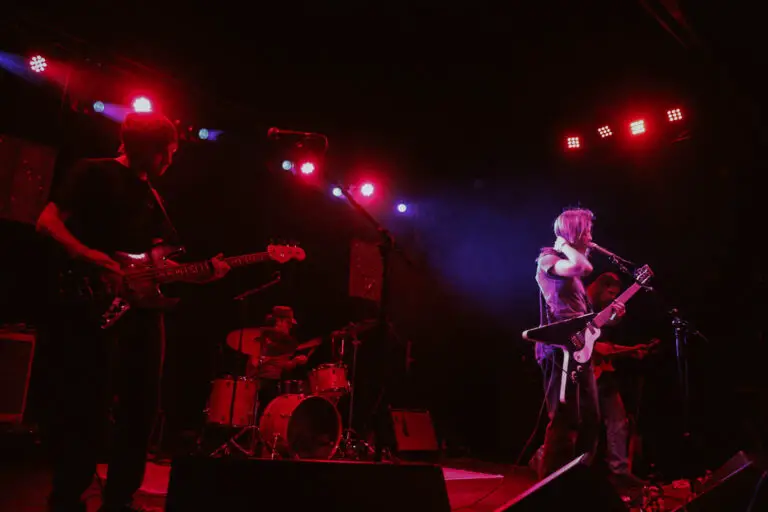
This show was extremely special, as it was a stand-alone double-headline show. Both Ratboys and Water From Your Eyes are on their separate tours, making this a special convergence. Additionally, the small size of the room creates an intimate environment fostering communication between the artist and the audience. The rare show became even more special, occurring in such a sacred place blending genres and audiences.
Through these shows, Bearsville continues to exemplify Albert Grossman’s mission of creating a place where fans and musicians celebrate live music. It’s a place where art, resources, and versatility are the main focus rather than capitalizing on musicians. Because of this, Bearsville remains an important cornerstone of Woodstock.

However, a music fan’s trip to Woodstock isn’t complete without experiencing the divine intervention that occurs at Levon Helm Studios. After the trek down the easily missable and winding driveway, fans can see first-hand where Levon Helm, the drummer of The Band, put his roots down in Woodstock in 1975 with the construction of his home and renowned studio barn. The barn was used to record sessions and hold live performances. Muddy Waters was the first artist to make an album in the studio.
Helm became enamored by the joy of his studio bringing artists together, and the community it fostered. In the 1990s, he got swept up by cancer treatments and a tragic fire destroying his home. The love and community persevered, and the property was rebuilt. In 2004, Helm welcomed the public into his studio for his Midnight Rambles. The invigorating jams included a house band with artists such as Amy Helm, Little Sammy Davis, Larry Campbell, and Teresa Williams to name a few, with other musicians partaking. The collaborations with different artists at each show, continue to share unique experiences with attendees.
When Levon Helm passed away in 2012, the barn’s use was expanded past The Midnight Ramble. His family, the team keeping Levon’s alive hold regular concerts, including The Midnight Ramble. Artists such as Mavis Staples, David Crosby, Bob Weir, etc. have taken the stage. Every show furthers the mission of honoring Helm’s legacy and creating a one-of-a-kind experience for fans and artists.
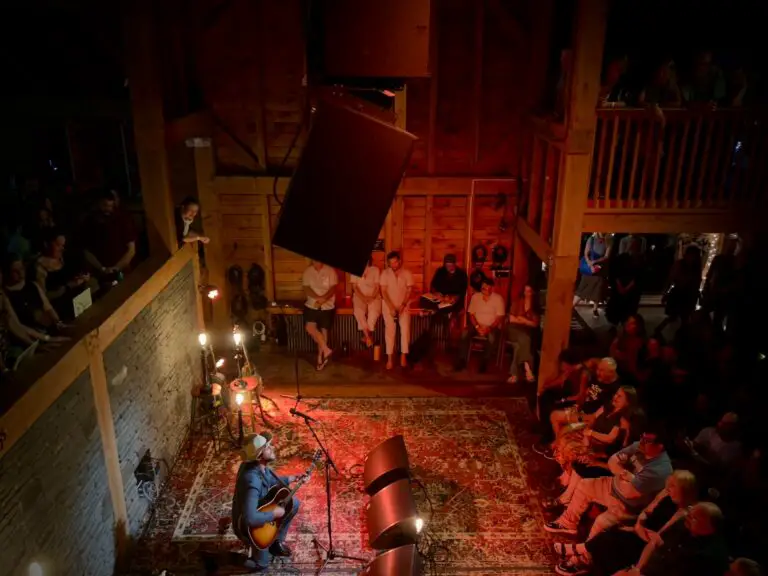
July 18 was a joyous day at Levon Helm Studios as Langhorne Slim made his anticipated return to the barn. Kicking off a small Northeast tour, the show was full of hope, observation, commentary, and in true Langhorne Slim nature, many stories. Because Levon’s has no actual stage, he made his way through the audience onto the floor. The balconies allowed everyone to gaze down at Slim with a full view, with every area offering a new perspective.
When he made his way to the center he took a few seconds to take in his surroundings and carefully look at as many people in his path. His raw, genuine songs and knack for storytelling brought the audience together, connecting the fans and artist on a new level. He even brought some fans up to sing with him. Though the venue is big and open for a recording studio, it remains extremely intimate for concerts. The show integrated even more art forms by hosting the venue’s live sketch artist to portray the performance authentically.
Music unites and inspires people. It creates a loving, open community right from the downbeat. I am proud to be able to share this space at “The Barn” for art in our community, built by musicians for musicians and music lovers alike.
Amy Helm
Overall, the importance of the work Levon Helm Studios does to not only honor Helm’s life but also bring new and old communities together individualizes every experience there. The immense historical value of the venue makes it one of the most exciting artifacts in town. Furthermore, their success in commemorating Helm and the Band’s accomplishments in Woodstock, while promoting the success of rising artists respects the town’s essence in the most significant way.
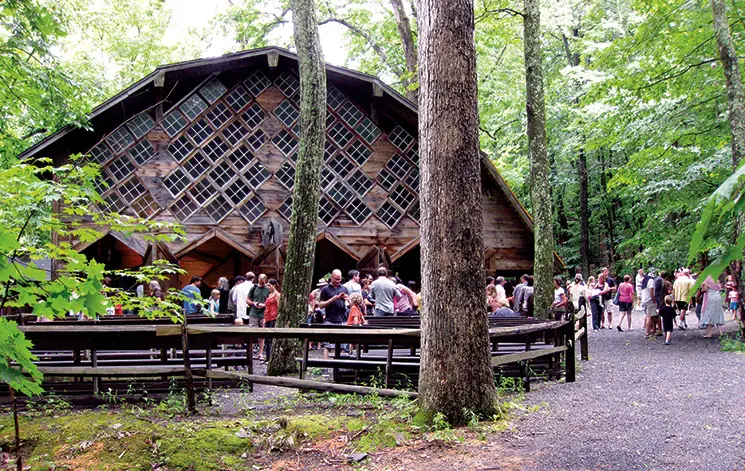
Apprapo to its history, Woodstock is also full of smaller and locally supported venues. Stemming from the aforementioned Maverick Art Colony, Maverick Concert Hall still stands. The building, which was a part of the colony, has held the longest continuing chamber music festival in the country. Known for chamber, jazz, and contemporary recitals, the concert hall continues to keep the music alive through versatile productions. Their non-profit, Maverick Concerts, Inc. works with the support of local businesses and state grants to carry on the mission of bringing the community together through art.
Another establishment still in use is the Woodstock Playhouse. What was once used for off-Broadway theatre productions, is now home to many artistic avenues. Patrons can enjoy not just theatre, but concerts, exhibitions, and festivals of all kinds, including the famous Woodstock Film Festival. The playhouse also provides educational outlets. Their Rock Academy Concerts allow students and teachers to exhibit their hard work and expanding talents.
Surrounding the Colony on Rock City Road, is the Woodstock Cemetary where The Band’s Rick Danko and Levon Helm are buried. Across the street is the Woodstock Artists Cemetary containing the graves of art colony founders Hervey White and Ralph Whitehead. Right next to the cemetery is Graveyard Variety, a small space for independent artists to showcase their music. The intimate nature of the venue creates an equilibrium between artists and the audience, as everyone’s there to observe and support.
In an effort to preserve the natural beauty of the landscape, the founding members sought to limit traditional symbols of grief. As a result, conventional tombstones and other visual intrusions were prohibited…Unique in its setting and vision, the Artists Cemetery continues to serve as a reminder of Woodstock’s countless contributions to the world of art, music, theater and the written word.
Richard Heppner

Other honorable mentions include Pearl Moon, Opus 40 and the Woodstock Film Festival. Pearl Moon combines a regular restaurant setting with entertainment. Offering different assortments of shows, the restaurant allows patrons to support live music on the daily. Opus 40 is a sculpture and park, in the town of Saugerties, a few minutes down the road from Woodstock. As a non-profit, the environment truly allows for pure indulgence in art, fostering a space for concerts, visual art, and public use. Lastly, the renowned Woodstock Film Festival continuously gives independent filmmakers to present their work. Over the past 25 years, the film festival has promoted art from established and emerging creatives.
Although each of the shows and venues reside in the same peaceful, folky, hippie-infused town, they offer an abundance of genres. From gentle bluegrass, and acoustic Americana to angsty alternative and passionate indie-rock. It’s an environment where musicians and music lovers are welcomed with open arms. It’s a personal experience where fans can walk in and see Mike Gordon having a drink at the bar. Or where three girls jump in excitement after the lead singer of a band they love happens to walk into the empty lobby.
Woodstock is a music scene in itself. The community behind it meticulously carries on the legacy of creating a safe space where art is the top priority. Current music fans constantly express nostalgia for an era in music named after the town. Unfortunately, not as many people know that the culture of Woodstock never left its namesake. And it will continue to exist through music, art, and preservation- not as an aesthetic, but as an immersive lifestyle.
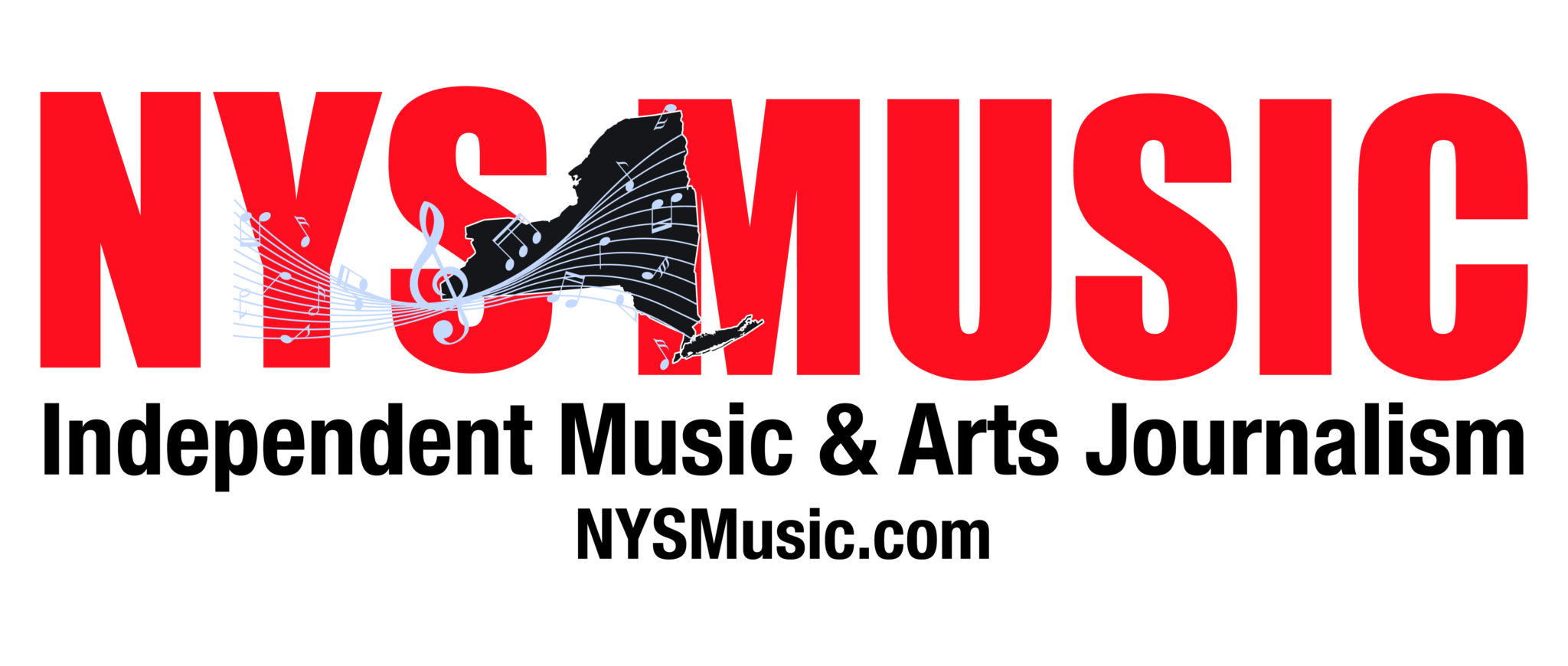

Comments are closed.